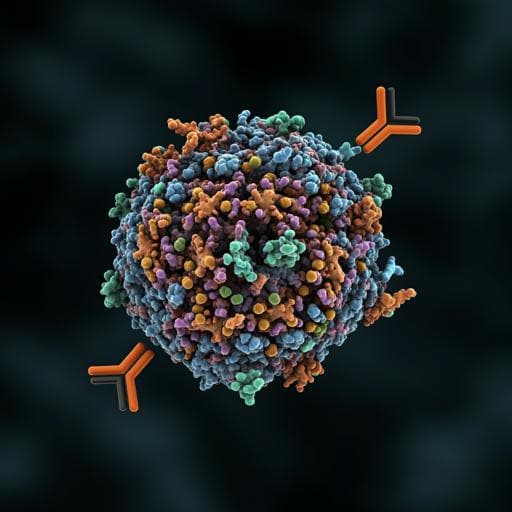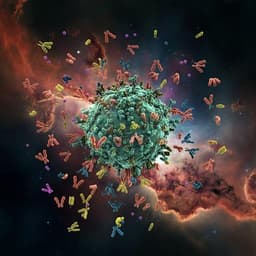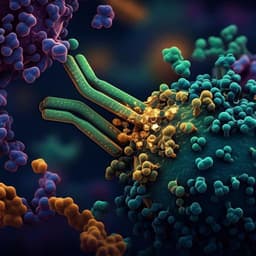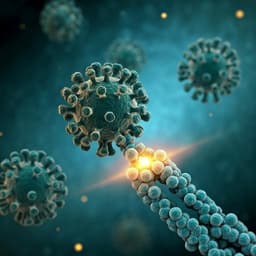
Medicine and Health
A broadly neutralizing humanized ACE2-targeting antibody against SARS-CoV-2 variants
Y. Du, R. Shi, et al.
Discover the groundbreaking research on h11B11, an ACE2-blocking monoclonal antibody that demonstrates exceptional efficacy in inhibiting SARS-CoV and SARS-CoV-2. Conducted by an expert team including Yanyun Du and Rui Shi, this study unveils promising therapeutic and preventive strategies against viral replication with minimal toxicity.
~3 min • Beginner • English
Introduction
COVID-19 has caused a global public health emergency with extensive morbidity and mortality. SARS-CoV-2 uses the spike (S) glycoprotein to bind human ACE2 for cell entry. While neutralizing antibodies targeting the SARS-CoV-2 RBD have shown efficacy, rapid emergence of escape mutations limits durability, and cross-protection across SARS-related coronaviruses is poor. Given ACE2 is the shared entry receptor for SARS-CoV and SARS-CoV-2, the study asks whether an ACE2-targeting monoclonal antibody can broadly block SARSr-CoV entry while preserving ACE2’s enzymatic function and demonstrate efficacy and safety in relevant models. The purpose is to develop and characterize a humanized ACE2-blocking antibody (h11B11) with broad antiviral activity against SARS-CoV-2 variants and SARS-CoV, assess its in vitro and in vivo efficacy, evaluate preliminary safety, and elucidate its structural mechanism of action.
Literature Review
Prior work established ACE2 as the receptor for SARS-CoV-2 and other coronaviruses, and several RBD-directed monoclonal antibodies received EUA for COVID-19. However, SARS-CoV-2 readily accumulates RBD mutations under therapeutic pressure, reducing sensitivity of many RBD-specific mAbs, and cross-neutralization between SARS-CoV and SARS-CoV-2 is limited. Receptor-targeting mAbs can be effective (e.g., ibalizumab against HIV-1 via CD4). Polyclonal anti-ACE2 sera blocked SARS-CoV-2 pseudovirus entry in vitro, but no ACE2-targeting mAbs had been reported clinically. Soluble ACE2 decoys and engineered high-affinity ACE2 variants show antiviral potential but may carry risks such as immunogenicity and altered enzymatic activity. These observations motivate exploring an ACE2-targeting therapeutic antibody with broad activity and preserved ACE2 physiology.
Methodology
- Antibody generation and humanization: BALB/c mice were immunized with soluble hACE2 (residues 19–615) using a prime-boost regimen. Hybridomas were screened for ACE2-binding and for blocking SARS-CoV and SARS-CoV-2 spike-pseudotyped virus infection of HEK293T-hACE2 cells. Clone 11B11 was selected and humanized by CDR grafting onto human germline frameworks, expressed as human IgG.
- Binding and blocking assays: Surface plasmon resonance (SPR, Biacore 8K) quantified binding kinetics of h11B11 to wild-type and variant hACE2 (S19P, I21T, K26R, N33D, D38E). Flow cytometry assessed blockade of RBD (SARS-CoV and SARS-CoV-2) binding to ACE2-expressing HEK293T cells.
- Enzymatic activity: In vitro ACE2 carboxypeptidase activity was measured using a fluorogenic substrate (Mca-APK-Dnp) in the presence of h11B11 (100–400 µg/ml), isotype IgG, or ACE2 inhibitor MLN-4760. Michaelis-Menten parameters (Km, kcat/Km) were derived.
- Pseudovirus neutralization: VSVΔG-luciferase pseudoviruses bearing S from SARS-CoV, SARS-CoV-2 (Wuhan), sustained transmission lineages (D614G, B.1.1.7, B.1.351), and 34 additional high-frequency/combined S variants were produced. Neutralization IC50 values were measured on HEK293T-hACE2 cells.
- Live virus neutralization: Dose-response neutralization against authentic SARS-CoV-2 on Vero E6 cells (IC50 by CPE readout). Activity against HCoV-NL63 on LLC-MK2 cells was also tested. Combination neutralization with clinical mAb CB6 was evaluated.
- Mouse efficacy: hACE2 knock-in mice (hACE2 cDNA inserted into mAce2 exon 2) were challenged intranasally with 5×10^5 TCID50 SARS-CoV-2. Prophylaxis: single intraperitoneal dose of h11B11 (5 or 25 mg/kg) one day before challenge. Therapy: single dose (5 or 25 mg/kg) one day after challenge. Mice were euthanized at day 5 post-challenge; lung viral RNA was quantified by qRT-PCR, and lung histopathology (H&E) assessed.
- Safety in nonhuman primates: Four male cynomolgus monkeys received repeated weekly IV infusions of h11B11 at 60 mg/kg (n=2) or 180 mg/kg (n=2) for 3 weeks. Monitored systolic/diastolic BP post-second dose, hematology (WBC, RBC, monocytes, lymphocytes), and serum chemistry (AST, ALT, CRP, TBIL) at baseline, days 7, 14, and 21. Cell-based assays assessed whether h11B11 alters ACE2 surface expression (western blot, membrane/cytoplasm fractionation, flow cytometry).
- Structural studies: Produced ACE2 (19–615) and h11B11 Fab; determined crystal structure of the ACE2–h11B11 Fab complex at 3.8 Å. Superimposed with structures of ACE2 bound to SARS-CoV RBD (PDB 2AJF), SARS-CoV-2 RBD (6LZG), and HCoV-NL63 RBD (3KBH) to analyze epitope overlap and steric effects.
Key Findings
- Binding/blocking: h11B11 blocked both SARS-CoV RBD and SARS-CoV-2 RBD binding to membrane-anchored hACE2 (up to 100% inhibition). SPR showed high affinity to hACE2 (KD = 2.95 nM), stronger than SARS-CoV-2 RBD (KD 36.4–133.3 nM) and roughly comparable to whole S (~15 nM), driven by a slower off-rate. Binding to ACE2 variants I21T, K26R, N33D, and D38E was similar to wild-type (KD 3.49, 1.58, 1.63, and 2.85 nM, respectively), but S19P abolished binding.
- ACE2 enzymatic function: h11B11 did not alter ACE2 carboxypeptidase activity. Km and catalytic efficiency (kcat/Km) were comparable to isotype IgG controls even at 400 µg/ml, indicating non-overlap of the antibody epitope with the catalytic site.
- Pseudovirus neutralization: IC50 against SARS-CoV pseudovirus was 0.98 µg/ml; against SARS-CoV-2 Wuhan strain 0.95 µg/ml. Sustained transmission lineages were potently inhibited: D614G 0.61 µg/ml, B.1.1.7 0.56 µg/ml, B.1.351 1.59 µg/ml. Across 34 additional S variants, potency was largely retained; slight (~4-fold) reductions were seen for N354D, N354K, and V367F.
- Live virus neutralization: Against authentic SARS-CoV-2, IC50 = 0.66 ± 0.03 µg/ml. Combination with mAb CB6 yielded synergistic potency (IC50 0.06 ± 0.01 µg/ml, ~0.4 nM). No inhibition of HCoV-NL63 at 100 µg/ml.
- Mouse efficacy: Therapeutic dosing (post-exposure) reduced lung viral RNA by ~10-fold vs. placebo at day 5. Prophylaxis (pre-exposure) at both 5 and 25 mg/kg reduced lung viral titers below detection in nine of ten mice. Histopathology showed minimal interstitial pneumonia and inflammation in prophylactically treated mice; 25 mg/kg also reduced inflammation vs. low dose and placebo.
- Safety: h11B11 did not reduce ACE2 surface levels on HEK293T-hACE2 cells over 4–24 h across concentrations. In cynomolgus monkeys, repeated weekly IV dosing at 60 or 180 mg/kg caused only minor BP fluctuations (means ~90–102 mm Hg after second dose) and stable hematology and serum chemistry over 3 weeks. Maximum tolerated dose in this setup was 180 mg/kg.
- Structural mechanism: The 3.8 Å ACE2–h11B11 Fab structure shows binding predominantly to the ACE2 N-terminal helix with ~266 Å^2 buried surface. Superposition with ACE2–RBD complexes indicates epitope overlap and steric hindrance with SARS-CoV and SARS-CoV-2 RBDs at the N-terminal helix, but not with HCoV-NL63 RBD, explaining the observed specificity profile.
Discussion
Targeting the shared entry receptor ACE2 with h11B11 provides broad neutralization across SARS-CoV, SARS-CoV-2, and multiple variants, addressing the limitation of RBD-directed mAbs that are vulnerable to viral escape. The antibody’s mechanism—epitope competition and steric hindrance at the ACE2 N-terminal helix—prevents spike RBD engagement without impairing ACE2’s enzymatic function, mitigating concerns about renin-angiotensin system disruption. In vitro and in vivo data demonstrate potent neutralization, strong prophylactic and therapeutic efficacy in hACE2 mice, and preliminary safety in nonhuman primates, with no detectable effect on ACE2 surface levels. The synergy observed with an RBD-directed clinical mAb (CB6) suggests combination strategies could further enhance potency and resilience to resistance. Lack of activity against HCoV-NL63 aligns with structural non-overlap of epitopes. ACE2 polymorphism S19P abolishes h11B11 binding but is rare and largely confined to specific populations, indicating broad applicability. Overall, h11B11 advances an alternative therapeutic modality that may remain effective against evolving SARS-CoV-2 lineages and potential future SARS-related coronaviruses.
Conclusion
This study identifies and humanizes an ACE2-targeting monoclonal antibody, h11B11, that broadly blocks SARS-CoV, SARS-CoV-2, and diverse variants by competing with RBD binding at the ACE2 N-terminal helix while preserving ACE2 enzymatic activity. h11B11 exhibits potent in vitro neutralization, robust in vivo prophylactic and therapeutic efficacy in hACE2 mice, and favorable preliminary safety in cynomolgus monkeys. Structural analysis elucidates the competitive, steric mechanism underlying its breadth. Future work should include comprehensive GLP-compliant toxicology with histopathology, pharmacokinetic/pharmacodynamic profiling, evaluation in additional animal infection models, assessment across newly emerging variants, and clinical trials, including combinations with RBD-directed antibodies to maximize efficacy and minimize resistance.
Limitations
- Safety evaluation was preliminary: only four cynomolgus monkeys, no histopathology of tissues, and a short observation window.
- Mouse model exhibits transient infection; outcomes limited to day 5 post-challenge.
- No efficacy against HCoV-NL63, consistent with structural non-overlap.
- ACE2 polymorphism S19P eliminates binding; although rare, it could limit efficacy in individuals carrying this variant.
- In vitro variant panel did not encompass all future or complex mutational constellations; real-world resistance remains possible.
Related Publications
Explore these studies to deepen your understanding of the subject.







